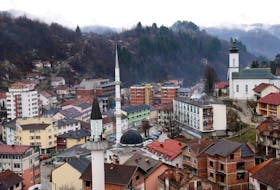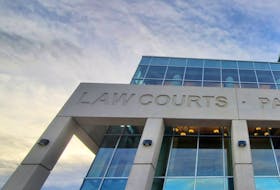While downtown St. John’s commuters wait to pass the area of Water Street where crews have been upgrading aging water and sewer infrastructure these past few weeks, archeologist Blair Temple is busy inspecting the dug-up road for historical artifacts.
Any digging in the downtown core of St. John’s requires the presence of an archeologist to collect artifacts.
Some of the oldest pieces found so far were dug up near the top of Bishop’s Cove — bits of broken pottery, pieces of wine bottles and tobacco pipe fragments that all seem to date back to the late 1600s.
Some might call it junk, but to historians trying to piece together the city’s history, it’s almost like finding gold.
“The 17th-century and 18th-century material that we found here at Bishop’s Cove is important because the way St. John’s has developed over the years, there’s a lot of destruction sometimes,” said Temple, standing near the construction site.
“The way cities function is you destroy something to build. It kind of works like that, and there’s not a lot of material from that period remaining in St. John’s, so it was nice to find it.”
Related story:
Water Street work starts Monday
The current upgrades to the water and sewer system below Water Street between Queen Street and Bishop’s Cove are the first phase in a five-year, $15.5-million project. There will be five phases in total, upgrading one section every year.
The area dug up around Bishop’s Cove was identified by the archeological team as a site of particular historical significance.
It’s adjacent to one of the earliest known fishing plantations in the city, dating to the 1600s and owned by a man named Thomas Oxford, one of the leading planters of the period.
Temple pointed to the parking lot next to Blue on Water.
“Right there is the oldest material in all of St. John’s,” he said, explaining that he was involved in a dig there 20 years ago when they found an early silver coin and a piece of gentleman’s jewelry that suggested the material found there related to a well-off household, likely the Oxfords.
So, while Temple said he was excited to find the 17th- and 18th-century artifacts and more evidence of the early fisheries, he wasn’t particularly surprised given what he had already found nearby.
Temple said any artifacts found have to be cleaned and researched.
“I’ll try to figure out, what’s the context of this?”
Temple said the project is “not traditional archeology in any way.”
He said it’s rare that he would break out a trowel or toothbrush on a job like this, in the middle of a construction site operating under a tight deadline.
The project is scheduled to be completely finished — roads paved and equipment gone — by June 30. Temple’s work will likely last only until the end of May.
He carefully collects the pieces and places them in clear bags labelled with pertinent information, such as the exact location where it was found.
Evidence of 1846 fire
Temple said one interesting thing about archeological work in St. John’s is that there have been so many large fires over the years, notably the Great Fire of 1892 and the Great Fire of 1846. Because of that, he often finds evidence of “total destruction.”
St. John’s had significant fires in 1816, 1817, 1819, 1846 and 1892.
While most of the evidence he has found so far of the 1846 fire is burn layers, he did find one “substantial piece of evidence.”
“It was actually quite deep and what it seems to be is actually a wooden building that burnt down.”
Temple said he found a lot of material among that fire debris.
“A lot of it was pottery and a lot of it was very similar in pattern and size, and I think it may have been a restaurant or something like that. I don’t know if I’d want to say that conclusively, but it looked like a lot of similar material, which would be odd for a house at that period.”
The next step once the digging portion of the first phase of the project finishes is to research what is known about the buildings and businesses that were in that location.
“We’ll try to determine was it in fact a restaurant, or is it just household debris?
“You try to get as much information on the material and the site that you’re looking at as you possibly can, basically to try to reconstruct a story, to understand what it is and how did it get there.”
Temple didn’t find any evidence of the 1892 fire because it didn’t come down that far — it ended roughly where YellowBelly Brewery currently sits.
Temple said there was a fire in the area in 1833 that he hasn’t found any definitive evidence of yet, but he found “possible evidence” of the 1819 fire, which ended roughly in the area of Bishop’s Cove.
Unusual sewer still functions
Temple said the most unusual thing he has found so far is a stone sewer that goes up Bishop’s Cove, crosses Water Street and continues up Adelaide Street.
“It’s unlike any stone sewer I’ve ever seen,” he said, noting he has been studying the sewer system in St. John’s for several years. “And it still functions. Most of the stone sewers are no longer functioning in the city. But it still functions right now, which is a bit problematic for me, obviously, because it’s a live sewer, so you can’t really do much with it.”
Temple said what makes it unusual is the manner in which its construction and size differ from any stone sewer he has encountered in St. John’s over the years. He said it was likely built in the 1840s.
It is mortared, but most sewers at the time were dry-laid, and it is deeper underground than was typical at the time.
“I have no idea why they put it there in the manner that they did, so that’s going to have to be something I do some future research on.”
Goal to unify piecemeal history
Temple works with Gerald Penney Associates. Owner and archeologist Gerald Penney said the water and sewer upgrades give them a rare opportunity to see beneath one of the oldest streets in North America.
Penney said the team is looking at the “bigger picture rather than finding scattered artifacts.”
“We’re trying to understand the growth and development of St. John’s right from its earliest days. We’re trying to put all of this stuff into context so that at the end of the day, I guess we’ll be presenting it as our version of the history of settlement and landscape usage in St. John’s from its earliest days.”
Since Gerald Penney Associates did the archeological work with the harbour interceptor project in 2004, they’ve been documenting everything they find in a manuscript, and will add the information from this upgrade work to that document.
Penney said they’ve had people ask if they’ve found underground tunnels, gold treasure and even the remains of Tommy Toe — the answer to all of those questions is no.
“The most interesting thing that we’ve found is a new way of looking at the history of St. John’s and a way of fitting everything — the little fragments, the little coins — into a larger picture,” said Robert Cuff, a historian with Gerald Penney Associates.
“My understanding of the history of St. John’s is it’s a very piecemeal piece of work that’s been done by a number of people,” added Penney. “What we’re trying to do, and hopefully will achieve, is a unification of all of that.”
Twitter: juanitamercer_








